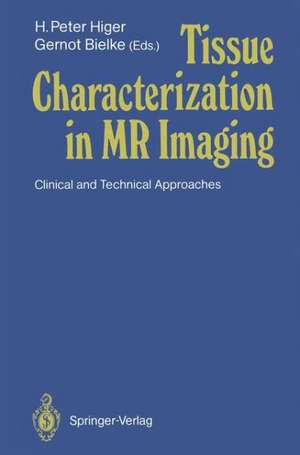Tissue Characterization in MR Imaging: Clinical and Technical Approaches
Editat de H. Peter Higer, Gernot Bielkeen Limba Engleză Paperback – 13 dec 2011
Preț: 719.38 lei
Preț vechi: 757.24 lei
-5% Nou
Puncte Express: 1079
Preț estimativ în valută:
137.65€ • 143.73$ • 113.67£
137.65€ • 143.73$ • 113.67£
Carte tipărită la comandă
Livrare economică 15-29 aprilie
Preluare comenzi: 021 569.72.76
Specificații
ISBN-13: 9783642749957
ISBN-10: 364274995X
Pagini: 364
Ilustrații: XVII, 340 p.
Dimensiuni: 155 x 235 x 19 mm
Greutate: 0.51 kg
Ediția:Softcover reprint of the original 1st ed. 1990
Editura: Springer Berlin, Heidelberg
Colecția Springer
Locul publicării:Berlin, Heidelberg, Germany
ISBN-10: 364274995X
Pagini: 364
Ilustrații: XVII, 340 p.
Dimensiuni: 155 x 235 x 19 mm
Greutate: 0.51 kg
Ediția:Softcover reprint of the original 1st ed. 1990
Editura: Springer Berlin, Heidelberg
Colecția Springer
Locul publicării:Berlin, Heidelberg, Germany
Public țintă
ResearchCuprins
I. Methods and Techniques Relaxation Parameters.- Relaxation Parameters.- General Need for Quantitative Methodologies in Tissue Characterization by MRI.- NMR Parameter Calculations.- The Application of Surface Coils for Tissue Characterization — Demonstrated by the Determination of T2 Relaxation Times.- Determination of T1 by Three-dimensional Measurement with Triangle Excitation.- Improving the Accuracy of T1 Measurements In Vivo: The Use of the Hyperbolic Secant Pulse in the Saturation Recovery/Inversion Recovery Sequence.- Volume-Selective Tissue Characterization by T1? Dispersion Measurements and T1? Dispersion Imaging.- Two New Pulse Sequences for Efficient Determination of Tissue Parameters in MRI.- Characterization of Brain Tissues by the Field Dependence of Their Longitudinal Relaxation Rates.- A Biochemical Approach to the Interpretation of MRI Images: In Vitro Study on a Craniopharyngioma.- Comparison of Algorithms for the Decomposition of Multiexponential Relaxation Processes Using SUNRISE.- Preprocessing of Magnetization Decays to Improve Multiexponential T2 Analysis.- Advantages of Multiexponential T2 Analysis.- MRI Relaxation of Brain Tissue: A Statistical Estimate of Deviations from Ideality.- Lower Error Bounds for the Estimation of Relaxation Parameters.- Signal Mechanisms and Influences.- Multiexponential Relaxation Analysis of Precontrast MRI in Comparison with Gadolinium-DTPA MRI.- A Chemical Shift Imaging Strategy for Paramagnetic Contrast-Enhanced MRI.- Experimental Approach to Rho-Related Contrast in Clinical MRI.- Serial Inversion Nulling Syntheses (“SINS”) to Enhance Lesion Contrast.- Pattern Recognition.- Tissue Characterization with MRI: The Value of the MR Parameters.- Using an “Information Manager” as a Component of a TissueClassification System in NMR Tomography.- MR Tissue Characterization Using Iconic Fuzzy Sets.- Tissue Discrimination in Three-dimensional Imaging by Texture Analysis.- Generation of Tissue-Specific Images by Means of Multivariate Data Analysis of MR Images.- Feature Extraction from NMR Images Using Factor Analysis.- Multispectral Analysis of Magnetic Resonance Images:A Comparison Between Supervised and Unsupervised Classification Techniques.- Textural Analysis of Quantitative Magnetic Resonance Imaging in Metabolic Bone Disease — An Approach to Tissue Characterisation of the Spine.- Tissue Type Imaging — An Approach to Clinical Use.- II. Clinical Results Musculoskeletal.- Musculoskeletal.- MRI Evaluation of Early Degenerative Cartilage Disease by a Three-dimensional Gradient Echo Sequence.- MRI vs Scintigraphy in the Detection of Vertebral Metastases:Preliminary Results.- MRI of Osteomyelitis.- MRI in Bone Infection.- MR Imaging After Trauma and Orthopedic Surgery.- MRI Tissue Characterization of an Anatomical Structure Subject to Major Functional Displacement: The Temporomandibular Joint.- Body.- Tissue Characterization of Focal Lesions by Liver MR Imaging.- Differentiation of Focal Liver Lesions by Contrast-Enhanced MRI.- Investigation of Liver Pathology with Magnetite-Dextran Superparamagnetic Nanoparticles as New MRI Contrast Agent.- Contrast-Enhanced MR Imaging of Urinary Bladder Neoplasms.- Stage I Endometrial Carcinoma: High Field (1.5T) MR Imaging Features.- Mamma.- Breast-Tissue Differentiation by MRI: Results of 361 Examinations in 5 Years.- T1 Measurements by TOMROP: First Experiences and Applications in In Vivo Breast Studies.- Miscellaneous.- Correlations Between NMR Relaxation Times and Histopathological Features in Abnormal Thyroid and ParathyroidGlands:Preliminary Results.- Proton NMR Relaxation Times and Trace Paramagnetic Metal Contents: Pattern Recognition Analysis of the Discrimination Between Normal and Pathological Tissue of the Gastrointestinal Tract and Bone Marrow.- Head and Brain.- Tissue Characterization in Brain Lesions: A Review of the State of the Art.- Quantitative Analysis of Multiple Sclerosis by Means of MRI.- Differentiation of Gliomas Using Tissue Parameters and a Three-dimensional Density Distribution Model.- Tissue Accessibility of Gd-DTPA in Meningiomas and Neuromas.- Eye Muscle Changes in Graves’ Ophthalmopathy:Differentiation by MRI.- Assessment of Clinical Activity in Endocrine Orbitopathy with T2 Values — Response to Immunomodulating Therapy.- MRI Tissue Characterization and Segmentation of Human Brain Tissues Using a Prolog-Based Expert System.- Calculated T1 and T2 in Nonresectable Brain Tumors to Monitor the Effects of Cranial Radiation.- Dexamethasone Effect on MR Parameters in Brain Tumors.- III. Round-Table Discussion.- Concluding Remarks.








